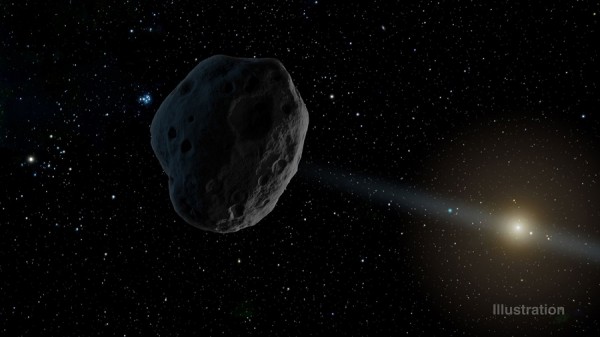By Ana Verayo, | January 02, 2017

An artist's rendition of 2016 WF9 as it passes Jupiter's orbit inbound toward the sun. ( NASA/JPL-Caltech )
Two new Near-Earth objects have been detected by NASA scientists. One of these cosmic objects is a comet, and the other one appears to be a mysterious, unknown cosmic object, which is yet to be confirmed.
Like Us on Facebook
NASA's NEOWISE mission is the asteroid-hunting part of the Wide-field Infrared Survey Explorer (WISE) mission. The NASA WISE space telescope was first launched in 2009.
This mysterious object is a comet asteroid hybrid that was first detected by WISE late in November last year. Astronomers have determined that WF9 completes 4.9 years of orbit around the sun, following Jupiter's orbital path, circulating between Earth and Martian orbits as well.
Astronomers say that the WF9 will arrive near Earth in late February some 32 million miles from the planet. To date, its origin and identity are still unknown. Scientists say that this object can be considered as a migrated comet or runaway asteroid.
Mission scientists say that the reason why they are still not sure if this is a comet or an asteroid is because its size, shape, and reflective properties appeared to be like a comet. However, the gas and dust cloud enshrouding it was non-existent as it is with other comets.
Apart from this mysterious object, scientists were able to confirm the identity of C/2016 U1 as a comet. Apparently, this comet possesses an orbit that lasts thousands of years. It will make its closest approach near Mercury's orbit before it returns to the outermost regions of the solar system.
According to NASA's Center for Near-Earth Object Studies manager, Paul Chodas of NASA's Jet Propulsion Laboratory, these objects can also be observed with a good pair of binoculars although comet brightness is highly unpredictable.
These objects are also considered large and really dark, appearing like charcoal or even darker, which can be difficult to spot when they enter the inner solar system. However, WISE was able to detect them since Near Earth objects can absorb light and emit them back as infrared radiation.
-
Use of Coronavirus Pandemic Drones Raises Privacy Concerns: Drones Spread Fear, Local Officials Say

-
Coronavirus Hampers The Delivery Of Lockheed Martin F-35 Stealth Fighters For 2020

-
Instagram Speeds Up Plans to Add Account Memorialization Feature Due to COVID-19 Deaths

-
NASA: Perseverance Plans to Bring 'Mars Rock' to Earth in 2031

-
600 Dead And 3,000 In The Hospital as Iranians Believed Drinking High-Concentrations of Alcohol Can Cure The Coronavirus

-
600 Dead And 3,000 In The Hospital as Iranians Believed Drinking High-Concentrations of Alcohol Can Cure The Coronavirus

-
COVID-19: Doctors, Nurses Use Virtual Reality to Learn New Skills in Treating Coronavirus Patients







